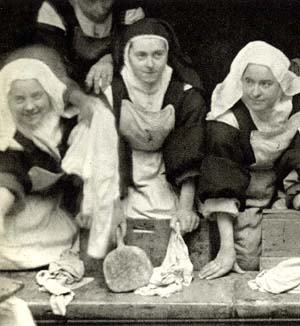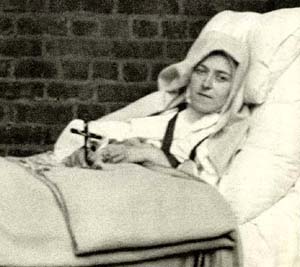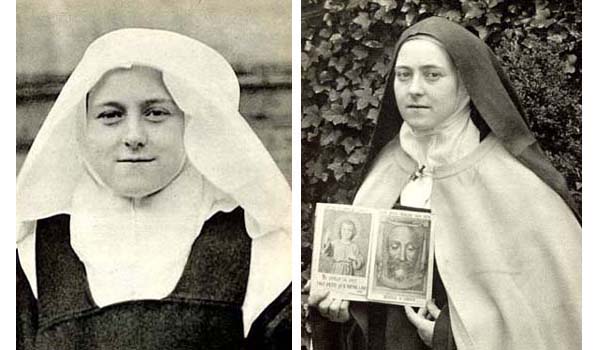 |
Catholic Virtues
St. Therese of the Child Jesus:
Master of Her Temperament
Marian T. Horvat, Ph.D.
On September 30, 1897, a 24-year-old nun lay dying in the Carmelite Convent in Lisieux, France. She had done so little in her life that one of sisters remarked that while she was charming, what would Mother Superior write about her at her death in the report she would make for the community?

A photo taken four days after the death of St. Therese, when she was still exposed in the choir
|
The question is amusing to us now. For the fame of this young nun would spread beyond the Convent and throughout the Church with remarkable speed. One year after her death, her autobiography, The Story of a Soul, was published. Her devotees multiplied as miracles were worked and favors granted through her intercession. During World War I French pilots carried a photo of her in their aircrafts to protect them.
In less than 30 years, in April of 1923, Pope Benedict XV declared her Blessed, and in 1925 Pius XI canonized her and named her feast day October 3. St. Pius X called St. Therese of the Child Jesus one of the greatest saints of modern times. In less than a century, she had become one of the most popular saints throughout the world.
A visage that reveals a great self-mastery

St. Therese of the Child Jesus. A deep gaze that shows suffering in a serene face with a slight smile
|
There is a popular iconography that represents St. Therese in statues and pictures with ruby lips, rosy cheeks, and an expression of sentimental piety and sanguine sweetness on her face. I am not a fan of this school of art that represents the saints like fairy tale figures stripped of character. To know St. Therese, it is best to contemplate her real face, since we are fortunate to have many pictures of her.
When her sister Celine entered the Lisieux Carmel in 1894, she brought her camera and photography equipment. Although the camera was banned in many Convents of the time as frivolous, Celine was permitted to pursue the hobby, and so today we have the 41 pictures in which St. Therese figured, either alone or in a group. (1)
What does the face of the real Therese reveal? It is a physiognomy that is delicate but strong, sweetly serene but intensely reflective, a face stamped with the tranquil acceptance of suffering and the life of the Cross. There is the strong chin, the firmly set lips with a hint of smile, a gaze that has lost nothing of its childhood innocence and, at the same time, reveals a person who views the world without superficiality or optimism. In the real face of St. Therese, one sees a soul of character and the self-mastery of a saint.
Self-mortification – the means to self-mastery
Looking at her sweet smile, it is hard to believe that it was a hard-earned smile that only a great self-mastery maintained through both the small irritations and great sufferings she endured in her short life. It is worth pausing a moment here because this kind of self-mastery, earned by mortification of one’s will, is the exact opposite of what the modern world advocates. In various ways, we are led to believe that the strong and successful woman is the one who gets her own way, who makes a stunning career, who controls every situation.
St. Therese teaches something different. “To write books of devotion, to compose the most sublime poetry is of less worth than the least act of renunciation,” she wrote. That she had learned the value of small acts of self-mortification from the time she was young is evident throughout her biography.

In the Convent washroom, July 1895
|
For example, when she was ten-years-old, her father offered Celine painting lessons, and then turned to Therese to ask her if she would like them also. Before she could answer yes, her sister Marie remarked that Therese did not have the same gift for it as Celine. She held herself back and remained silent, offering her great desire for lessons as a sacrifice. Later, in her autobiography, she remarked, “I still wonder how I had the fortitude to remain silent.”
She maintained this spirit in her years at Carmel. In the convent laundry of Lisieux, for example, she worked opposite a Sister who would splash her with dirty water while washing the handkerchiefs. She refrained from her inclination to draw back and wipe her face to show the Sister how much this annoyed her. This may seem very small, but the self will is as well denied and curbed in small things as in great things, and sometimes more so when they go against the grain.
St. Therese explained this “Little Way” (2) with simplicity and candor:
“Far from being like to those great souls who from their childhood practice all sorts of macerations, I made my mortification consist solely in the breaking of my will, restraining a hasty word, rendering little services to those around me without making anything of it, and a thousand other things of this kind.”
The exterior demeanor influences the interior
In the face of St. Therese, her lips are set in the way of one who is accustomed to keeping watch over herself, of smiling when she “feels” irritable or sad, of not allowing herself to be the slave of passing moods or fancies. From her, we learn an important lesson often ignored today by parents or teachers – the importance of the exterior demeanor as a means for controlling the interior.

Therese had already been sick for some months when this photo was taken in July 1896 in the sacristy patio
|
She used to tell the novices that out of respect for the Angels we should always carry ourselves with dignity. She could not bear to see the least contraction on their faces, such as frowning. She told them: “The face reflects the soul. So it must always be calm and serene. That holds good even when you are alone, because you are always in the sight of God and his Angels.”
In her Story of a Soul, St. Therese explained how she formed the habit of conquering her moods:
“When things that are irritable or disagreeable befall me, instead of assuming an air of sadness, I respond by a smile. At first I was not always successful, but now it is a habit which I am very happy to have acquired.”
It was this habit that made her able to maintain a peaceful demeanor even during the horrible physical sufferings and terrible temptations against the Faith at the end of her life. Her expression then was so serene that one Sister doubted her suffering during her sickness and confronted her, asking her how she could keep the expression of joy on her countenance if she was suffering so much.
“It is because of the very acute pain I am feeling,” replied Therese. “I have always striven to love suffering, both small and great, and to give it a cordial welcome.”
Confidence, the weapon to fight discouragement
Someone might wonder: Didn’t St. Therese ever become discouraged over her small failings and inability to do the great things she desired for the love of God?
In fact, Therese had by her temperament a natural tendency toward discouragement. That she recognized this disposition is evident from the first of the three resolutions she made on her First Communion day: “I shall not be discouraged.” (3)

In her last months resting in the Cloister, August 1897
|
In Carmel, she wrote a beautiful prayer for a novice about humility. In it she said that she would wake in the morning with a strong resolve to conquer her pride; in the evening she would be discouraged knowing she had failed. Then she realized that this discouragement itself was but itself a form of pride, and this would make her more discouraged. It is the vicious circle many of us have experienced. St. Therese explains how the dilemma was resolved:
“Since it has been given to me to understand the love of the Heart of Jesus, I own that it has chased all discouragement from mine. The remembrance of my faults humiliates me, and urges me never to depend on my own strength, which is nothing but weakness. Still more does this remembrance speak to me of mercy and of love. When, with all filial confidence we cast our faults into the devouring furnace of love, how should they not be totally consumed?”
It was only confidence that could conquer discouragement and melancholy. “What offends Jesus, what wounds Him to the Heart,” she insisted to her novices, “is lack of confidence.”
She did not permit this reliance on divine mercy and confidence in the goodness of God to allow any kind of passivity in the daily battle. Once a novice was bewailing her lack of courage. St. Therese chastised her for the spirit that relies on the “feeling” of the moment:
“Where would your merit be if you fought only when you felt courage? What does it matter if you have none, provided that you act as if you had! If you feel too lazy to pick up a bit of thread, and you nonetheless do it for the love of Jesus, you have more merit than some great accomplishment made in a moment of fervor.”
Confidence in the mercy and goodness of God does not release us from the obligation to fight the daily battles against our faults. But in fighting those battles, St. Therese found her support in it: “It is confidence, and confidence alone, that must lead us to love.”
She used to say that it was not because she had been preserved from mortal sin that she had so much confidence. Even if she had “committed every possible crime,” she said, she would have the same confidence. She would feel that this whole mass of sins would be like a drop of water thrown into a burning furnace. (4) For if we know how to lay siege to His Heart, she insisted, we render Him blind to our lamentable deficiencies.
If we do all that we can, she said, and offer this to the good God, in His justice and love He will supply the rest. “My way is all confidence and love,” affirmed St. Therese, telling us something we need to hear again and again, that we can never have too much confidence in the goodness of God.
Like St. Therese, we should not fear in these difficult days to ask Our Lady for everything: that she permit us to serve her in the defense of the Catholic Cause, that we might be saints, that the Church might be restored, that Her Reign might come, that Her Immaculate Heart be victorious.

Therese as a novice, January 1889. Joy, hope, and innocence.
Therese as a professed nun, June 1897. Grandeur, suffering and serenity
|
1. Stephane-Joseph Piat, O.F.M., Celine, Sister Genevieve of the Holy Face (San Francisco: Ignatius, 1967), pp. 62-5.
2. For more on the Little Way, see my tape, “The Spirituality of St. Therese.”
3. The second resolution was “I shall say the Memorare to the Blessed Virgin every day;” the third was “I shall blot out my pride with humility.”
4. St. Therese composed this prayer, An Act of Holocaust as Victim of God’s Merciful Love on June 9, 1895, as an expression of her desire to be consumed by Divine Love.

Posted September 28, 2003
|
Catholic Virtues | Religious |
Home | Books | CDs
| Search | Contact Us
| Donate

© 2002-
Tradition in Action, Inc. All Rights Reserved
|
 |
|